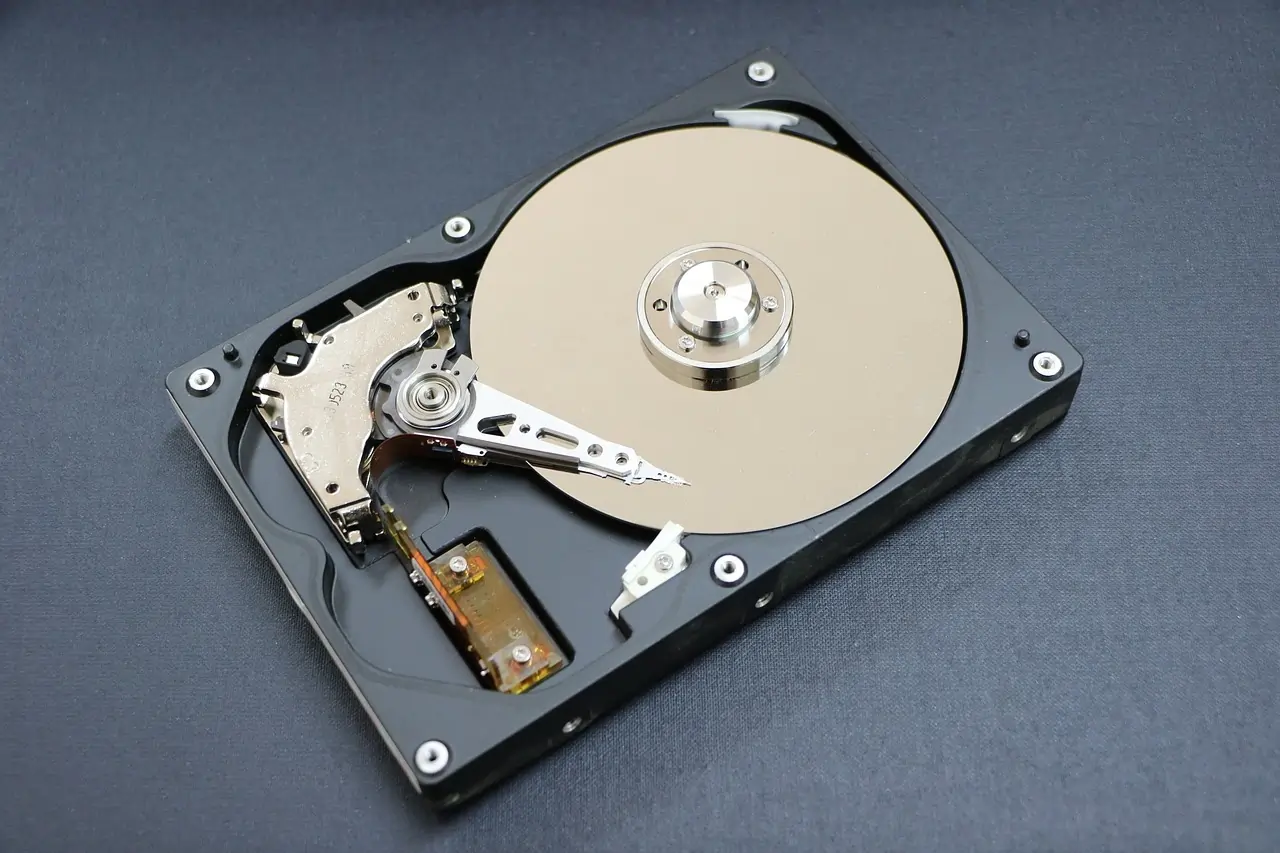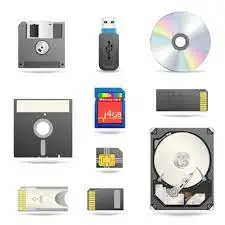Secondary Storage Devices of Computer
Secondary storage devices refer to computer hardware that allows permanent or non-volatile storage, retrieval and use of data in a computer. Secondary storage, unlike primary storage, retains its data even when the device is powered off. Some common examples of secondary storage devices are hard disk drives, solid-state drives, USB flash drives, SD cards etc.
Secondary storage allows computers to have persistent memory – the ability to retain data even when powered off. This enables users to store programs and data permanently. The large capacity affordably available makes secondary storage an integral part of computers.
What is Secondary Storage?
Secondary storage, also known as external memory and auxiliary storage, refers to computer data storage devices that can retain digital data even when not powered. People primarily use it for storing data that needs to be retained for future use.  The data in secondary storage devices can be accessed, modified and deleted much like in primary memory such as RAM. But unlike volatile RAM, secondary storage retains data without electrical power. Secondary storage devices are non-volatile.
The data in secondary storage devices can be accessed, modified and deleted much like in primary memory such as RAM. But unlike volatile RAM, secondary storage retains data without electrical power. Secondary storage devices are non-volatile.
Common examples of secondary storage devices are hard disk drives, solid-state drives, optical disc drives, USB flash drives, memory cards and magnetic tapes. These provide much higher data storage capacity than primary memory.
Modern personal computers have secondary storage devices that can store terabytes of data while also having speed comparable to that of RAM. This has enabled people to use secondary storage not just for backups but also for regular computing tasks.
Types of Secondary Storage
There are different types of secondary storage devices and technologies available. Some major categories are:

Hard Disk Drives (HDDs)
Round platters with a magnetic coating store data in hard disk drives. HDDs use read/write heads to access and modify data on the rotating disks.
HDDs are non-volatile, provide high capacity storage from hundreds of GB to tens of TB, and have become very affordable. HDDs remain the predominant secondary storage device for computers because of their favorable cost per byte.
Solid State Drives (SSDs)
Instead of rotating platters, solid-state drives use integrated circuits to store data. SSDs use flash memory and have no moving parts. Compared to traditional HDDs, SSDs are typically more reliable and faster.
SSD adoption has steadily grown thanks to plunging prices and capacity increases. For the same storage capacity, SSDs consume less power than HDDs. Durability, compact form factors and improved speeds have made SSDs the preferred choice in many computers.
Cloud Storage
Cloud storage refers to storing data on remote servers operated by Cloud computing providers. It allows access to the stored data over the internet.
Cloud storage provides benefits such as high availability, easy data sharing across devices, offsite backups and data mirroring. Leading cloud storage providers include Google Drive, Dropbox, Microsoft OneDrive and Apple iCloud.
Optical Disc Drives
Optical storage devices store and read data from discs. Optical disc drives scan tracks and bits on CDs, DVDs, and Blu-ray discs to access data when the discs are inserted.
Recordable optical media also allows users to write data to them. However, HDDs and SSDs typically have higher capacity than optical discs. Burned optical discs can also be less durable compared to magnetic or solid-state storage.
USB Flash Drives
Cost per unit storage on flash drives has also rapidly declined while capacities have ballooned to multiple hundred GB. Easy portability has enhanced the utility of flash drives for transferring and sharing data across devices.
SD Cards
Like flash drives, Secure Digital (SD) cards provide solid-state secondary storage in compact sizes. People commonly use them in smartphones, digital cameras, handheld consoles, and other portable devices to store photos, videos, music, and other media.
SD cards offer storage capacities comparable to smaller SSDs along with fast read/write speeds. Their durable form factor also suits mobile use cases. SD cards are available in micro, mini and regular sizes based on device compatibility.
Now, understanding this concept is simple and entertaining for Hasons. Using the Hason website you can always stay one step ahead in your job, business, or studies by purchasing New Age Desktops and All in One Desktops, i3 Intel Core Processor Desktop starting from 15000/-. Monitors, CPUs, and Gaming Desktop are also available. Register on Hasons and order your Tech Partner Now. Get exciting offers and benefits on your every purchase. Contact us so our support team can guide you in purchasing the right Tech Partner.
SSD 512 AIO Desktop Of HASONS With Processor Gen I3 12100, Chipset Series Q670, Windows 10 Pro, 512 SSD, DDR4-8GB, Wired Keyboard & Mouse, Black Screen 23.8
Shop Now
Use of Secondary Storage in Computers
Because of secondary storage’s non-volatile nature and large capacities, computers utilize it for crucial functions:

Permanent Storage of Data: Primary memory in computers is too small and volatile to store data permanently. Secondary storage Safely allows long-term retention of files, photos, software installers media etc. needed in the future.
Installing Software & Operating Systems: Users install application software like MS Office, Photoshop, and games on secondary storage once, rather than loading them every time. The operating system is also installed and booted from secondary storage.
Archival Storage: Users shift older, rarely accessed data from primary storage to secondary storage for long-term preservation while freeing up working memory.
Backup & Recovery: Secondary storage provides the means for system and file backups that become invaluable in case of data loss, disaster recovery or hardware failures.
Transferring Data Between Devices: Portable secondary storage devices facilitate easy transfer of data from one device to another without internet connectivity.
Benefits of Secondary Storage
Secondary storage devices deliver valuable advantages:
- Non-Volatile Storage: Data is retained even when powered off. This enables permanent storage of data.
- High Capacity: Secondary storage offers vastly larger capacities compared to primary memory and can store terabytes of data.
- Persistence: Data and software remain loaded without needing to reload each time the system boots up.
- Portability: External and removable secondary storage options like USB drives facilitate easy transfer of data between devices.
- Durability: Most secondary storage media provides reliable long term retention of data for decades if stored properly.
- Backups: Secondary storage enables backups critical for data and system recovery in case of failures and disasters.
- Archiving: You can move old and rarely used data to secondary storage without cluttering primary storage.
- Cost Effectiveness: You can obtain large-capacity secondary storage more economically compared to volatile primary memory.
Conclusion
Secondary storage has become an indispensable component of modern computer systems and user workflows. Non-volatile high capacity secondary storage devices uniquely satisfy the persistent data storage and portability needs.
Secondary storage capacity, speed and affordability has radically improved over the years while use cases have diversified. Emerging solid state and cloud storage technologies continue to further the capabilities of secondary storage. Users now rely extensively on secondary storage for installing software, archiving data, enabling backups and transporting data.
| If you are Reading Secondary Storage Devices of Computer then also check our other blogs: | |
| Magnetic storage Devices | Ryzen 7 vs i7 |
| Digital Identity | Web Application Security |
Secondary Storage Devices of Computer

